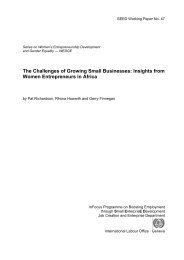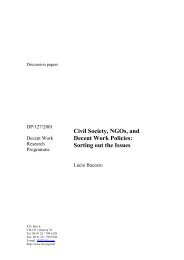manual: women workers' rights and gender equality - International ...
manual: women workers' rights and gender equality - International ...
manual: women workers' rights and gender equality - International ...
Create successful ePaper yourself
Turn your PDF publications into a flip-book with our unique Google optimized e-Paper software.
• Discuss the different situations from the role plays using the following questions:<br />
- Why is this sexual harassment?<br />
- Does this happen often?<br />
- What can you do about it?<br />
Step 3<br />
• Discuss the 3 main types of sexual harassment briefly:<br />
- sexual assault <strong>and</strong> rape<br />
- sexual blackmail<br />
- creating a hostile working environment<br />
• Summarize the different types <strong>and</strong> forms of sexual harassment <strong>and</strong> give a definition of sexual<br />
harassment<br />
Step 4<br />
• Ask the group to think about the effects of sexual harassment. Let them think about effects on<br />
the victim, the enterprise <strong>and</strong> society<br />
• Discuss what kinds of action can be undertaken to prevent sexual harassment <strong>and</strong> provide<br />
assistance in cases of sexual harassment<br />
Step 5<br />
• Summarize the things done <strong>and</strong> learned during this session<br />
Notes for the trainer<br />
The definition most commonly cited comes from the 1990 European Commission’s Council<br />
Resolution on the protection of the dignity of <strong>women</strong> <strong>and</strong> men at work: “Sexual harassment means<br />
unwanted conduct of a sexual nature, or other conduct based on sex, affecting the dignity of<br />
<strong>women</strong> <strong>and</strong> men at work. This can include unwelcome physical, verbal or non-verbal conduct”.<br />
Definitions used in laws, codes, policies, court decisions <strong>and</strong> collective agreements throughout the<br />
world may differ in details, but, generally contain the following key elements:<br />
- conduct of a sexual nature <strong>and</strong> other conduct based on sex affecting the dignity of <strong>women</strong><br />
<strong>and</strong> men, which is unwelcome, unreasonable, <strong>and</strong> offensive to the recipient<br />
- a person’s rejection of, or submission to, such conduct is used explicitly or implicitly as a<br />
basis for a decision which affects that person’s work or prospects for work<br />
- conduct that creates an intimidating, hostile or humiliating working environment for the<br />
recipient<br />
The most serious types of sexual violence that may take place at work are sexual assault <strong>and</strong><br />
rape, <strong>and</strong> these are outlawed everywhere. The two other principal types of sexual harassment in<br />
the workplace are ‘quid pro quo’ harassment or sexual blackmail <strong>and</strong> the creation of a hostile<br />
working environment, both of which need to be included in any definition to provide adequate<br />
protection.<br />
- Quid pro quo (meaning ‘this for that”) harassment forces a worker to choose between<br />
giving in to sexual dem<strong>and</strong>s or losing a job or job benefits. Because quid pro quo<br />
harassment can only be committed by someone with the power to give or take away an<br />
employment benefit, this form of sexual harassment constitutes an abuse of power. This<br />
type of sexual harassment is also referred to as ‘sexual blackmail’.<br />
- Unwelcome sexual advances, requests for sexual favours or other verbal, non-verbal or<br />
physical conduct of a sexual nature can also poison the work atmosphere <strong>and</strong> limit the<br />
108

















